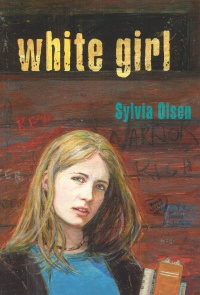| ________________
CM . . .
. Volume XI Number 21 . . . .June 24, 2005
excerpt:
Three years after she becomes a "white girl," Josephine Joanne Jessop—Josie, as she is known to most—five feet three and a quarter inches tall, ninety-six pounds, blue-eyed and a genuine blonde, finds herself reflecting on the events of the past three years of her life. She is at an Institute for the Arts and is working on an assignment, a 500 word response for her communications class. It's about perspective, and so is this book, White Girl. There's no question that Josie is gifted with the ability to perceive things from a variety of perspectives, and it is a gift that serves her well when, at the age of 15, her life, and her perspective on life, changes. Her mom, a woman who seems to have a "permanent case of semi-depression," meets Martin, "a real ponytail Indian," a "combination between Harvey Keitel and Antonio Banderas." While Martin definitely is better than Prozac for Jose's mom, nothing could possibly prepare Josie for life on the reserve which follows Martin and her mom's marriage. Moving from the city, she morphs from being Josie to "Blondie," faces all manner of difficulty at school, in her newly-blended family (particularly with newly-acquired step-brother, Luke), and in a community which is, at best, oblivious to her, and at worst, genuinely hostile. But, there are positive experiences, too: with Rose, her school-bus buddy, genuine friendship develops, proving that 16-year-old girls are 16-year-old girls, no matter where they live; with Martin's mother, there is a bond that goes beyond generations and race; and then, there's Zeb, incredibly cool, incredibly hot, and totally fascinating, in the way that only a gangster-hippie, seventies-style guy can be. White Girl resonates with a reality that comes from having lived this experience, as Sylvia Olsen has. Life on the reserve—its profound difficulties and its amazing strengths—emerge with an extraordinary power. The adults in this story have their failings, but they do the best they can, and as the story evolves, we honour their struggles and accept their weaknesses. And at the end of it, Josie, the white girl, accepts the richness of the life she has been given, and the gift of perspective to see beyond the surface, and to hear "stories [she] had never heard before and [to know that] this was only a beginning." Recommended Joanne Peters is a teacher-librarian at Kelvin High School in Winnipeg, MB.
To comment
on this title or this review, send mail to cm@umanitoba.ca.
Copyright © the Manitoba Library Association. Reproduction for personal
use is permitted only if this copyright notice is maintained. Any
other reproduction is prohibited without permission.
NEXT REVIEW |
TABLE OF CONTENTS FOR THIS ISSUE
- June 24, 2005.
AUTHORS |
TITLES |
MEDIA REVIEWS |
PROFILES |
BACK ISSUES |
SEARCH |
CMARCHIVE |
HOME |
